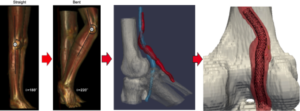Introduction
The popliteal artery (PA) is located behind the knee and it could suffer a unique set of pathologic conditions such as aneurysm or atherosclerotic stenosis. The use of minimally invasive therapies such as stenting is limited because the long-term patency rates are poor. In fact, even self-expanding stents often structurally fails due to the severe loading imposed by the complex artery kinematics.
Goal
Given such considerations, it is clear that a focused engineering effort is required to quantitatively assess the PA kinematics and the mechanical response of stent-like devices implanted in that vascular region.
Method
In the present study we reconstruct the PA kinematics from medical images imposing then the computed vessel displacement as a loading condition to a stent model, in order to evaluate its solicitation in a realistic conditions. In particular, we have elaborated two Computed Tomography Angiography datasets of the leg, one in straight position and one in bent position, to compute how change the vessel shape during the leg bending. Subsequently, we perform structural finite element analysis of the stent deformation under the action of reconstructed vessel kinematics (see Figure 1).
Key clinical collaboration: Cisanello Hospital (Pisa)
Group publications
- [P1] M. Conti, M. Marconi, G. Campanile, A. Reali, D. Adami, R. Berchiolli, F. Auricchio. Patient-specific finite element analysis of popliteal stenting. Submitted.

Fig. 1: Illustrative sketch of the adopted workflow: starting from images we compute the vessel kinematics of the popliteal artery due to the leg bending, which is then imposed to the stent model by FEA to compute the corresponding device solicitation.

